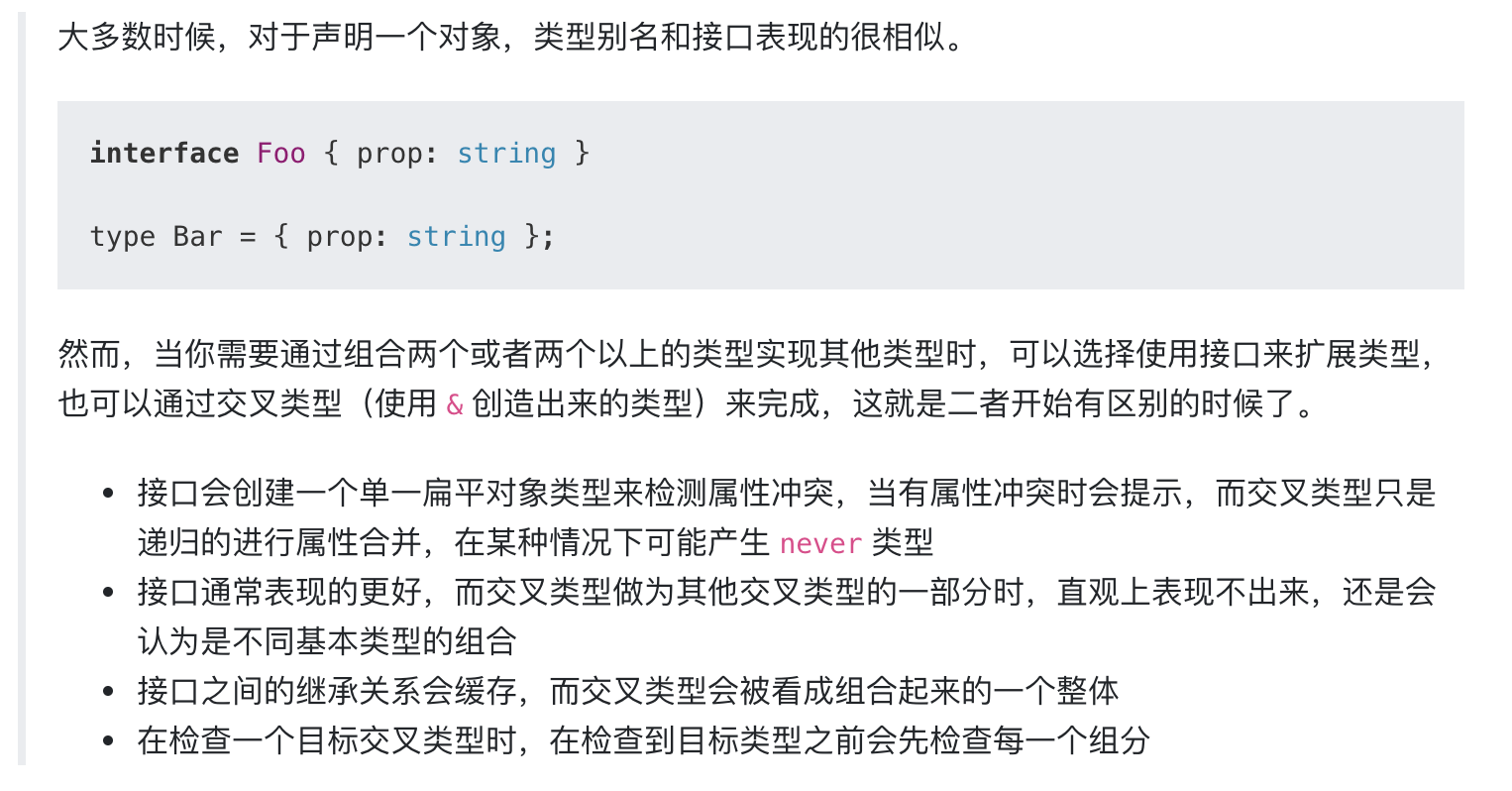TypeScript Interface vs Type知多少
接口和类型别名非常相似,在大多情况下二者可以互换。在写TS的时候,想必大家都问过自己这个问题,我到底应该用哪个呢?希望看完本文会给你一个答案。知道什么时候应该用哪个,首先应该了解二者之间的相同点和不同点,再做出选择。
接口 vs 类型别名 相同点
1. 都可以用来描述对象或函数
interface Point {
x: number
y: number
}
interface SetPoint {
(x: number, y: number): void;
}type Point = {
x: number;
y: number;
};
type SetPoint = (x: number, y: number) => void;2. 都可以扩展
两者的扩展方式不同,但并不互斥。接口可以扩展类型别名,同理,类型别名也可以扩展接口。
接口的扩展就是继承,通过 extends 来实现。类型别名的扩展就是交叉类型,通过 & 来实现。
// 接口扩展接口
interface PointX {
x: number
}
interface Point extends PointX {
y: number
}// 类型别名扩展类型别名
type PointX = {
x: number
}
type Point = PointX & {
y: number
}// 接口扩展类型别名
type PointX = {
x: number
}
interface Point extends PointX {
y: number
}// 类型别名扩展接口
interface PointX {
x: number
}
type Point = PointX & {
y: number
}接口 vs 类型别名不同点
1. 类型别名更通用(接口只能声明对象,不能重命名基本类型)
类型别名的右边可以是任何类型,包括基本类型、元祖、类型表达式(&或|等类型运算符);而在接口声明中,右边必须为结构。例如,下面的类型别名就不能转换成接口:
type A = number
type B = A | string2. 扩展时表现不同
扩展接口时,TS将检查扩展的接口是否可以赋值给被扩展的接口。举例如下:
interface A {
good(x: number): string,
bad(x: number): string
}
interface B extends A {
good(x: string | number) : string,
bad(x: number): number // Interface 'B' incorrectly extends interface 'A'.
// Types of property 'bad' are incompatible.
// Type '(x: number) => number' is not assignable to type '(x: number) => string'.
// Type 'number' is not assignable to type 'string'.
}但使用交集类型时则不会出现这种情况。我们将上述代码中的接口改写成类型别名,把 extends 换成交集运算符 &,TS将尽其所能把扩展和被扩展的类型组合在一起,而不会抛出编译时错误。
type A = {
good(x: number): string,
bad(x: number): string
}
type B = A & {
good(x: string | number) : string,
bad(x: number): number
}3. 多次定义时表现不同
接口可以定义多次,多次的声明会合并。但是类型别名如果定义多次,会报错。
interface Point {
x: number
}
interface Point {
y: number
}
const point: Point = {x:1} // Property 'y' is missing in type '{ x: number; }' but required in type 'Point'.
const point: Point = {x:1, y:1} // 正确type Point = {
x: number // Duplicate identifier 'A'.
}
type Point = {
y: number // Duplicate identifier 'A'.
}到底应该用哪个
如果接口和类型别名都能满足的情况下,到底应该用哪个是我们关心的问题。感觉哪个都可以,但是强烈建议大家只要能用接口实现的就优先使用接口,接口满足不了的再用类型别名。
为什么会这么建议呢?其实在TS的wiki中有说明。具体的文章地址在这里。
以下是Preferring Interfaces Over Intersections的译文:

上述的几个区别从字面上理解还是有些绕,下面通过具体的列子来说明。
interface Point1 {
x: number
}
interface Point extends Point1 {
x: string // Interface 'Point' incorrectly extends interface 'Point1'.
// Types of property 'x' are incompatible.
// Type 'string' is not assignable to type 'number'.
}type Point1 = {
x: number
}
type Point2 = {
x: string
}
type Point = Point1 & Point2 // 这时的Point是一个'number & string'类型,也就是never从上述代码可以看出,接口继承同名属性不满足定义会报错,而相交类型就是简单的合并,最后产生了 number & string 类型,可以解释译文中的第一点不同,其实也就是我们在不同点模块中介绍的扩展时表现不同。
再来看下面例子:
interface PointX {
x: number
}
interface PointY {
y: number
}
interface PointZ {
z: number
}
interface PointXY extends PointX, PointY {
}
interface Point extends PointXY, PointZ {
}
const point: Point = {x: 1, y: 1} // Property 'z' is missing in type '{ x: number; y: number; }' but required in type 'Point'type PointX = {
x: number
}
type PointY = {
y: number
}
type PointZ = {
z: number
}
type PointXY = PointX & PointY
type Point = PointXY & PointZ
const point: Point = {x: 1, y: 1} // Type '{ x: number; y: number; }' is not assignable to type 'Point'.
// Property 'z' is missing in type '{ x: number; y: number; }' but required in type 'Point3'.从报错中可以看出,当使用接口时,报错会准确定位到Point。
但是使用交叉类型时,虽然我们的 Point 交叉类型是 PointXY & PointZ, 但是在报错的时候定位并不在 Point 中,而是在 Point3 中,即使我们的 Point 类型并没有直接引用 Point3 类型。
如果我们把鼠标放在交叉类型 Point 类型上,提示的也是 type Point = PointX & PointY & PointZ,而不是 PointXY & PointZ。
这个例子可以同时解释译文中第二个和最后一个不同点。
结论
有的同学可能会问,如果我不需要组合只是单纯的定义类型的时候,是不是就可以随便用了。但是为了代码的可扩展性,建议还是优先使用接口。现在不需要,谁能知道后续需不需要呢?所以,让我们大胆的使用接口吧~
原文链接:https://segmentfault.com/a/1190000039834284
